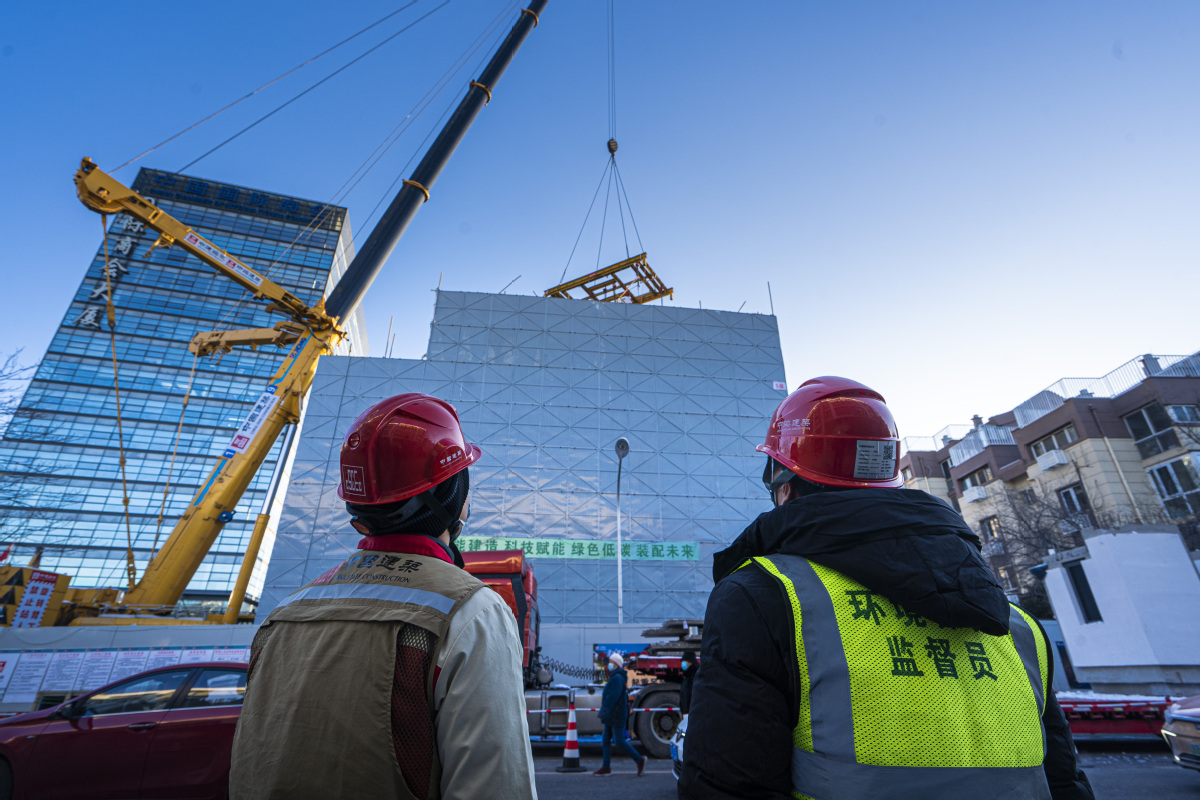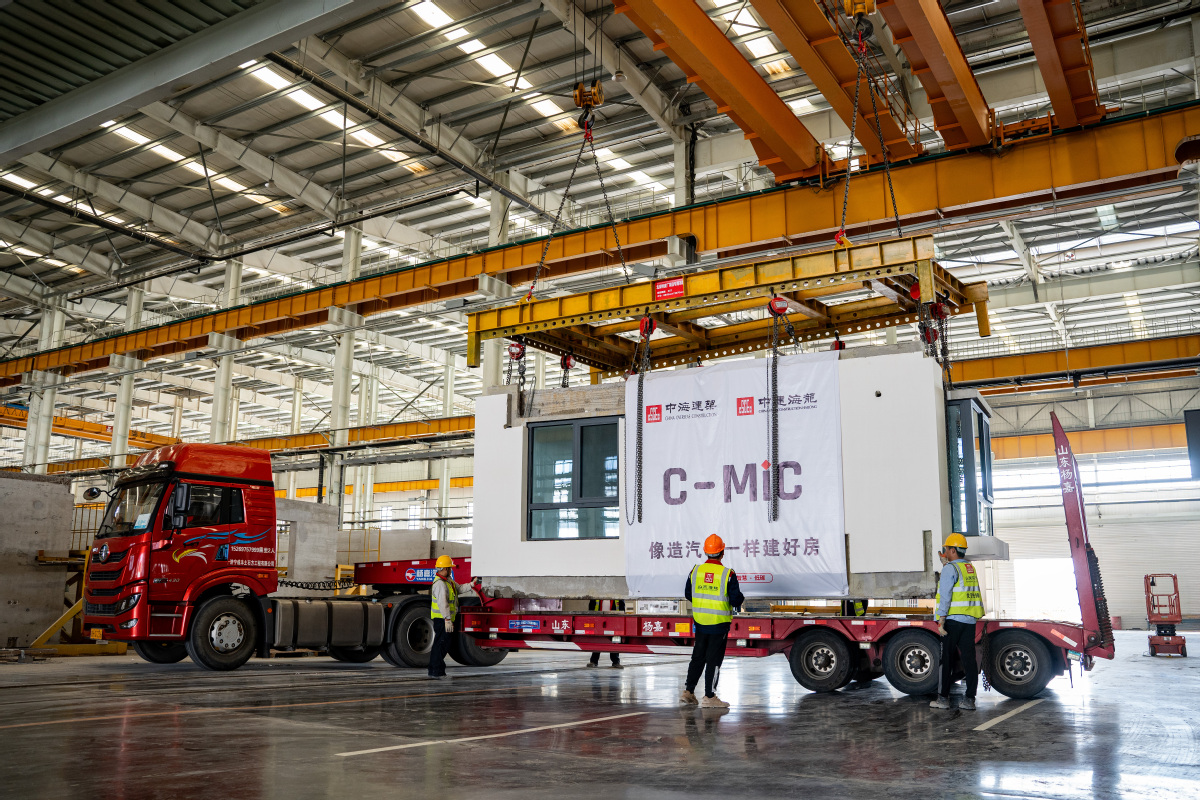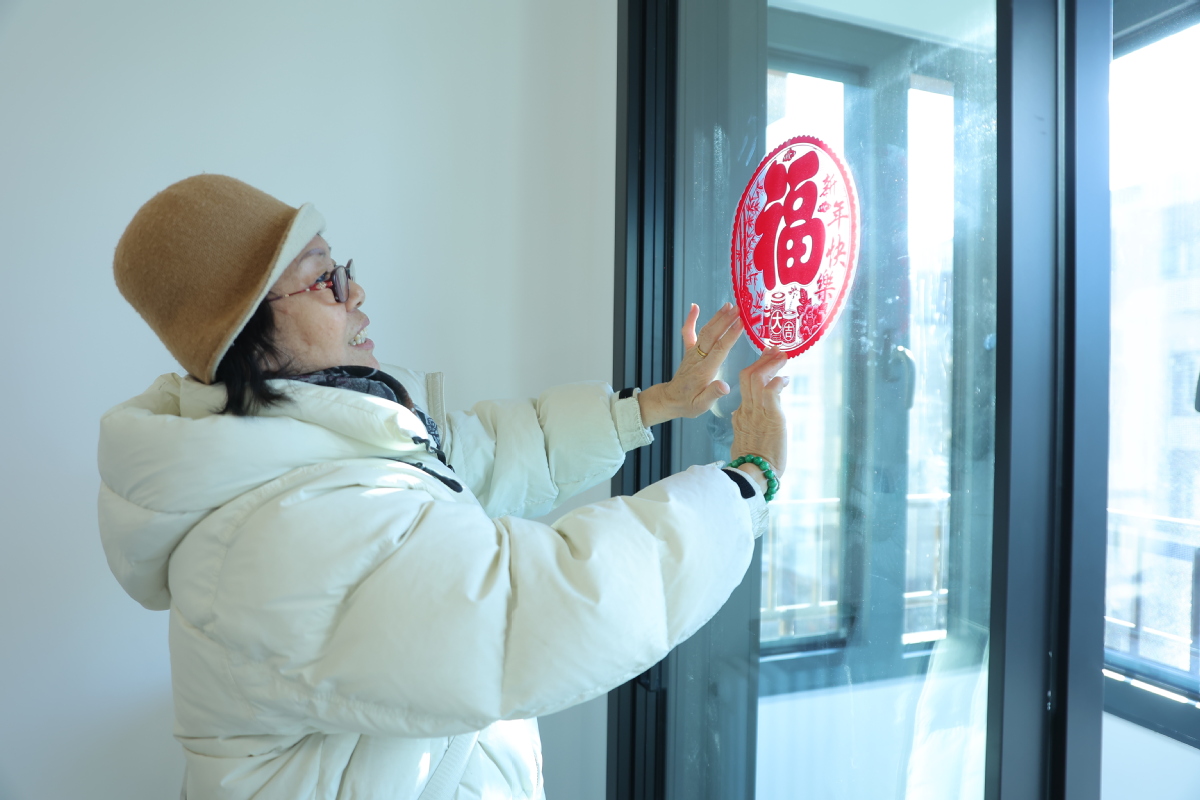
Employees of China State Construction International Holdings Ltd supervise the installation of housing modules at the Huapichang Hutong No 8 Building redevelopment project in Beijing in January.
Being able to go back home soon is always good news to be told. And Jin Guilian, a resident of Beijing's Xicheng district, was told such news last week after three months of "long wait", as redevelopment of the No 8 building in the Huapichang Hutong Community — where she and her 19 neighbors had been living in for decades — will soon be completed.
In fact, for a time-worn housing project established in the 1970s, a redevelopment period of only three months is not generally deemed by builders as a long wait, considering there is tons of work to finish before the new building is finally erected, but for the resettling residents, "it's never too early to get back to the new house".
As transformation unfolds across the capital city, many old residential communities like Huapichang Hutong are undergoing a facelift. According to an urban renewal plan released by the Beijing government in 2022, more than 160 million square meters of aged community area will be redeveloped and renovated by 2025.
In the plan, sustainability and environmentally friendly building are highlighted by the government for developers and builders concerned. In particular, large-scale demolition and construction of projects is prohibited to avoid disturbing normal social operations and people's daily lives.

Employees of China State Construction International Holdings Ltd load completed housing modules to be installed at the Huapichang Hutong No 8 Building project at a facility in Zhuhai, Guangdong province.
And when it was Huapichang Hutong's turn last year, what its redevelopment undertaker China State Construction International Holdings Ltd (CSCI), a unit of China State Construction Engineering Corp, was facing were some real hard nuts to crack — a location in an alley near the central urban Second Ring Road, a sustainable building commitment to fulfill and an old No 8 Building of which every supportive facility is old.
"We thought it would be a project lasting for years, which, if it were the real case, would have triggered piles of complaints, because many of us living in this building are seniors who are not supposed to go through a whole resettlement process," said Liu Qingshun and his wife, residents of the No 8 Building.
"In the past three months, we almost came back from the temporary accommodation to the construction site every day. And day by day, we found something unfamiliar taking place in the community we are most familiar with," Liu said.
It is indeed not hard to notice the difference on the construction site of the project, as in the Huapichang Hutong community, gone are the noisy construction sites with flying mud and dust clouds. Instead, cranes gently piece together housing modules that are all set and well-decorated, creating a serene environment in the quiet alley.
What CSCI did to echo the call of the urban renewal plan was to seamlessly blend advanced technology with the finesse of reconstructing a building as if it were a giant's delicate game of building blocks.
"Modular integrated construction, what we call MiC, is a greener way of building homes. Think of it like assembling parts in a factory before bringing them to the construction site," said Tao Yang, project manager of the No 8 Building redevelopment.
"Compared to traditional methods, MiC shortens construction periods by over 60 percent. In the case of the Huapichang Hutong project, we achieved an 80 percent in actual construction time," Tao added.
With a total construction area of 374 square meters, the five-story residential building accommodates 20 units. The builder prepared 55 concrete modular units in advance to ensure the project was on track to finish upon schedule in 90 days — way faster than the estimated 15 months with traditional methods.
"The project team had been prioritizing green, low-carbon and energy-efficient principles during construction, and 90 percent of the work was done in factories. Ultimately, we not only managed to reduce material waste by 25 percent, but also cut overall construction waste by 75 percent," said Tao.
"Building blocks" though the whole on-site construction process seems to be, there were tons of coordinating work among various building processes such as prefabrication, transport and installation, which, in this case, were all carried out by CSCI's C-SMART platform — a digital management system that connects data across design, factories, logistics, construction sites and installation.
"The C-SMART platform enables real-time and intelligent control of the entire construction process, allowing managers to oversee module transport and coordinate warehouse, transit depot and construction site operations. It played a very important role in urgent project construction like the Huapichang Hutong, while alleviating pressure on surrounding traffic and the environment," said Guo Yang, C-SMART manager of the project.
With a due completion date before Chinese Lunar New Year, construction workers are putting finishing touches to the brand new No 8 Building, where making indoor visits is now safe and permitted. Some of its residents took the opportunity to have a glance at the new homes they are about to resettle in. Some even brought festive decorations during the visits to prepare for Spring Festival gathering.
"My new home has excellent light and ventilation, and it is such a relief that finally there is an elevator in this building. My neighbors and I are all satisfied and extremely happy with our new house," said resident Jin.

An Chunhua, a resident of Huapichang Hutong No 8 Building, decorates her newly redeveloped house with a festive paper cutting on window in Beijing in January.
Like the Huapichang Hutong project of the CSCI, projects concerning livelihoods nationwide have long been participated in by major Chinese builders, as "the urgency, significance and other special points of notice of such projects call for years of building experience and high efficiency in fields such as logistics and prefabrication", said Long Chaocan, an investment consultant with China Galaxy Securities Co Ltd.
"Participation of major Chinese builders in urban renewal projects demonstrates their supportive role in helping drive the nation's socioeconomic development and promoting livelihoods. This, in turn, offers them better experience and credentials while bidding for similar projects overseas, especially those in the markets involved in the Belt and Road Initiative, where such demand has been booming in recent years due to growing urbanization," Long said.
In recent years, the nation's infrastructure edge has gained way much reputation in BRI economies than before, not only with landmark projects, such as the new central business district rising in the desert area of Egypt, but also with those elementary projects which, however, are necessary to local livelihoods.
A project in Papua New Guinea explains it well. Located in the Kila Kila village near Port Moresby, the Butuka Academy, completed by the CSCEC in 2018 under the BRI, has become a key educational infrastructure for local primary and secondary school students who had difficulty attending school in the past.
With the voices of students reading aloud across the village, the largest multi-functional school, which has the most advanced facilities in the South Pacific, has indeed become a marvelous credential of Chinese building enterprises overseas.
(From China Daily)